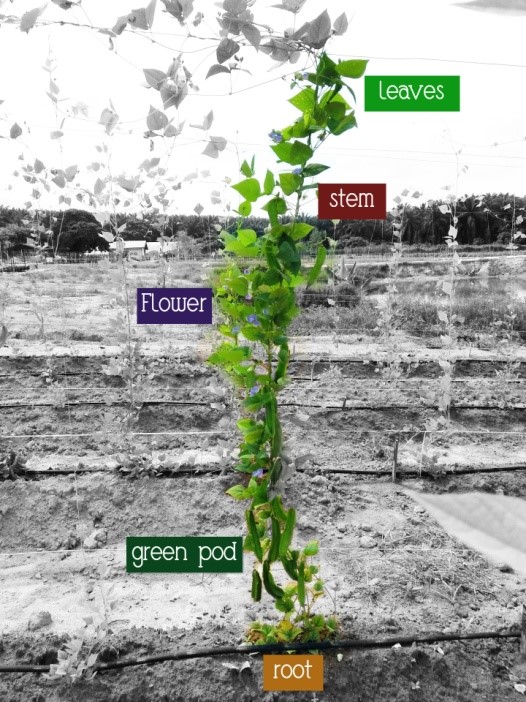
September 30, 2020, by Andrew Edwards (Ed)
Crops for the future: the case of the winged bean – by Chong Yuet Tian
Future Food Beacon researchers in Malaysia and the UK are working with partners globally to utilise crop diversity to plug gaps in food production. We aim to address nutrition security challenges by making a diverse range of healthy food crops available and accessible to all.
In addition to the flagship project on Bambara groundnut, Future Food Beacon researchers are also researching winged bean (Psophocarpus tetragonolobus), popularly known as “One Species Supermarket” for its nutrient-dense green pods, immature seeds, tubers, leaves, and mature seeds. All these parts are rich sources of protein, carbohydrate, vitamins, minerals and fibre. In particular, winged bean contains up to 40% protein in the mature seeds, making it a good source of plant-based proteins.

Winged bean root, also known as tuber, of winged bean harvested from the field
Like many other legumes, winged bean is capable of fixing atmospheric nitrogen for its own use and simultaneously contributes to soil fertility because the plants also leave behind available nitrogen. This beneficial trait supports low-input farming systems in the tropics and it is crucial for sustainable crop production.
Despite many benefits in winged bean, the crop remains underutilised with unexploited potential, largely due to lack of research investment and wider inclusion in agricultural systems. The international research efforts dedicated to this crop in 1970’s and 1980’s were not sustained. A number of production and consumption constraints remain unresolved, including the winged bean’s vigorous vining and indeterminate growth habits, both of which make it difficult to mechanise. It is also relatively hard to cook and contains anti-nutritional factors, thereby restricting wider utilisation of dry mature seeds.

A number of plant traits as possible breeding targets for winged bean improvement programmes are shown (https://link.springer.com/article/10.1007/s00425-019-03141-2).
Our current research project builds on previous work – collaboration between UoN Malaysia and CFF (Crops for the Future). We are assessing a wide range of germplasms collected across tropical countries to develop a core collection of materials for breeding and research focusing on yield and quality traits. We are also advancing segregating populations derived from controlled crosses involving diverse parental material. In addition to the development of new improved varieties, the structured populations and breeding lines will also provide resources for genetic analysis and marker-trait association studies for possible application in the field.




Growing winged bean at different locations with different types of plant support


Winged bean mature seeds after harvest (left); winged bean pod can reach up to the size of one adult’s lower arm, approximately 30 cm (right)

I planted these winged beans from July here in Sacramento area and they are not having flowers or fruits. It’s now mid August and came to find out that they will not bare fruits until September or October. So I just wait although they are blooming well, hoping they Wii’s fruits by the time they will get dry and die.
I came accross some veggie enthusiasts about the winged bean as a good crop to propagate and also as a good source of food for self-sustainability in the backyard. That’s why in no time, I also planted a few beans a couple of days ago (approximately 10 days). As of today no signs of sprouts, but I will wait until some will come out.
I have discovered that there are day neutral varieties which will flower and produce in a time line that does not require such a long growing season. I think the long growing season is not a plus for best use of resources – water, land allocation. Some seed sources indicate their variety is day neutral. I suspect that the seeds are not day neutral unless specifically noted. Next year will plant only day neutral for quicker production.